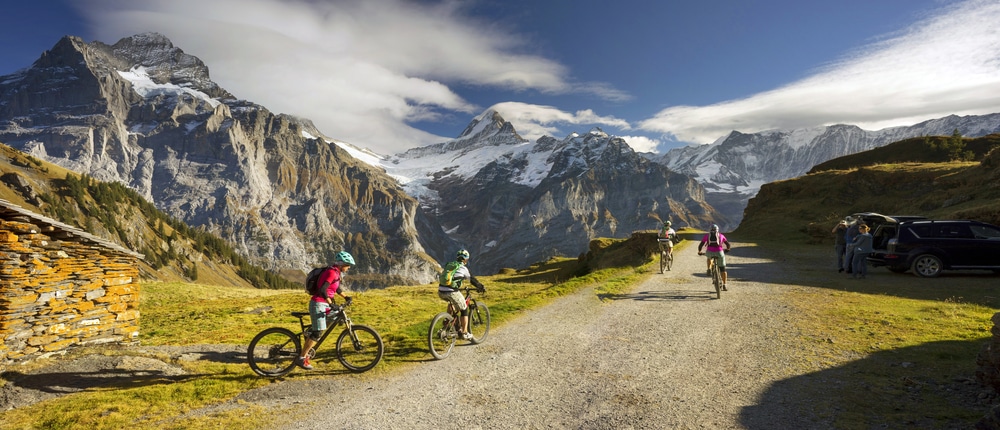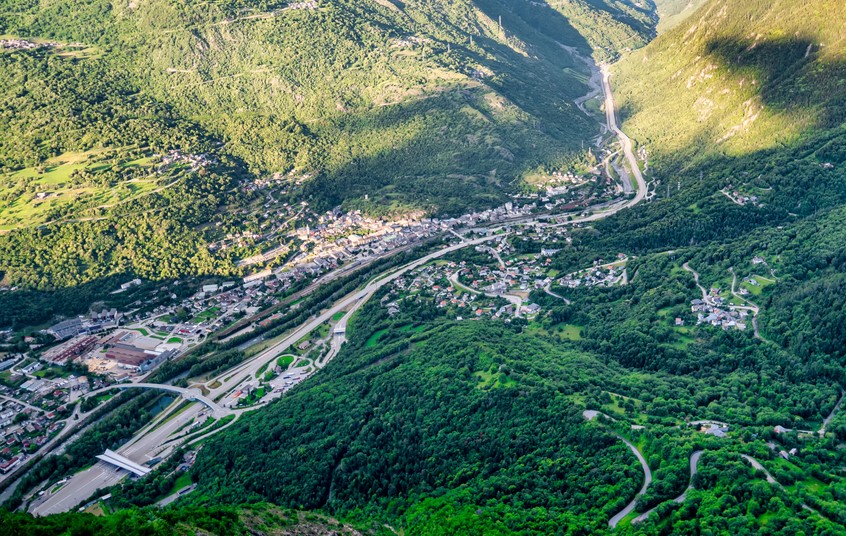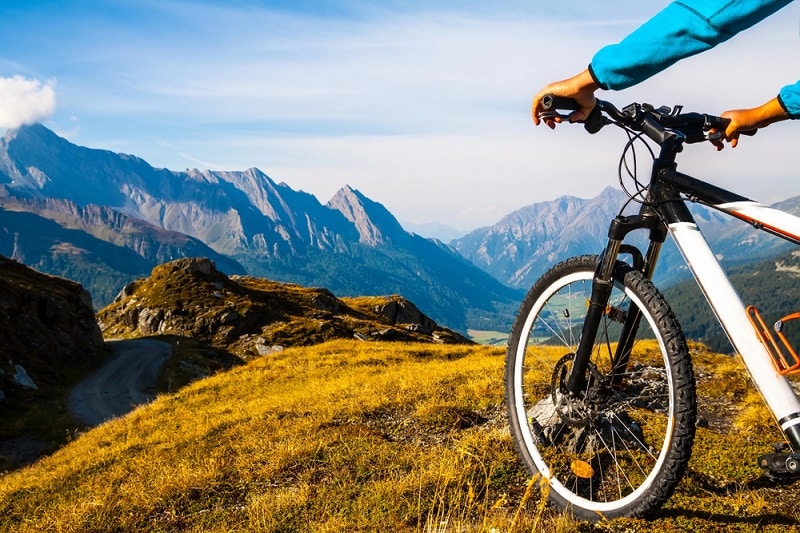Posted on 12 February 2024
For avid cyclists who love breathtaking scenery, cycling in the French Alps should be on your bucket list. Indeed, many people buying property, just associate the alps with the famous reputation for skiing. But outside of the winter months, the alps become an outdoor playground with cyclists flocking from around France and the world.
With majestic mountains, tough climbs, and stunning landscapes, the French Alps offer unforgettable experiences. From the famous Mont Ventoux to the legendary Col du Tourmalet, there is no shortage of classic climbs featured in cycling’s most prestigious races, like the Tour de France.
Cycling through this majestic landscape immerses riders in nature’s splendour, with every turn revealing captivating vistas. Whether climbing steep mountain passes, navigating technical descents, or cruising along scenic valleys, the Alps offer terrain to suit all cyclist’s preferences and abilities.
The Alps, home to iconic cycling climbs, from legendary passes like Alpe d’Huez, Col du Galibier, and Mont Ventoux to lesser-known gems, test cyclists’ strength, endurance, and determination. While climbs may steal the spotlight, exhilarating Alpine descents are equally memorable. Cyclists will find warm welcomes and camaraderie among fellow riders and bike-friendly infrastructure, including bike shops, accommodations, and cycling clubs.
About Cycling in the French Alps – Preparation

1: Choose the Right Time
The best time to cycle is typically during summer, with mild weather and clear roads. However, prepare for sudden weather changes, as mountain climates can be unpredictable. The French Alps are known for their high-altitude mountain passes, so choose the right time of year to ensure safe and enjoyable cycling conditions. Summer months, from June to September, are generally the best time as the weather is mild and mountain passes are usually snow-free.
2: Plan Your Route
Research and plan your cycling routes in advance. The French Alps offer various options, from gentle scenic rides to demanding ascents. Choose routes that suit your abilities and interests. Some popular routes include Col du Galibier, Col de la Colombiere, and Alpe d’Huez. Consider using online cycling platforms or maps to plan your routes in advance, considering distance, elevation gain, and points of interest.
3: Pack Essentials and Shape Up
Remember to pack the necessary cycling gear and equipment. Ensure you have a well-maintained bike, helmet, appropriate clothing for various weather conditions, sun cream, energy bars, and essential tools for repair and maintenance. Train and build up endurance before your trip to ensure an enjoyable experience. Before embarking on your cycling adventure, physically prepare for challenges. Include plenty of hill training in your regular cycling routine, and build up stamina by participating in longer rides. Invest in high-quality gear, including padded cycling shorts and layers for varying weather conditions.
Tips for Enjoying Cycling Experiences
Always carry well-stocked repair kits, including spare tubes, pumps, and essential tools, in case of mechanical issues on your bike ride. Stay hydrated and nourished during your rides, as high altitudes and physical exertion can quickly lead to fatigue. And most importantly, always wear a helmet and obey traffic rules to ensure your safety. So, lace up your cycling shoes, hop on your bike, and prepare for an incredible journey.
Best Places to Cycle
Renowned for their breathtaking landscapes, challenging climbs, and thrilling descents, the French Alps offer an unparalleled cycling experience. From iconic mountain passes to tranquil valleys, the region boasts several routes that cater to every cyclist’s desire for adventure.
Alpe d’Huez: No list of cycling destinations would be complete without mentioning the legendary Alpe d’Huez. Renowned for iconic 21 hairpin bends and gruelling 13% average gradient, this climb has been a staple of the Tour de France since 1952. Cyclists flock to tackle the ascent, which offers stunning views. Consider riding multiple ascents in a single day or testing your mettle against the clock on the infamous time trial course for an added challenge. The nearby Alpe d’Huez Bike Park features downhill trails, while surrounding mountains offer endless opportunities for cross-country adventures.
Lake Annecy: While high mountain passes may steal the spotlight, the French Alps also feature stunning lowland rides. One gem is the picturesque route around Lake Annecy, often called the “Venice of the Alps.” The gently rolling terrain and crystal-clear waters make for leisurely rides suitable for cyclists of all abilities. Stop and admire stunning views from numerous lakeside cafes or beaches.
Bourg d’Oisans: Sitting near Alpe d’Huez, Bourg d’Oisans beckons cyclists with promises of epic climbs and coniferous forests. Renowned for nearby iconic passes like Alpe d’Huez and Lac Du Chambon, as well as charming alpine villages and verdant valleys, Bourg d’Oisans is waiting to be explored. At the heart of cycling in Bourg, d’Oisans are legendary mountain passes that have become synonymous with the region’s cycling heritage.
As well as Alpe d’Huez, other nearby climbs, like Col du Galibier, Col du Glandon, and Col du Lautaret, offer equally formidable ascents, making Bourg d’Oisans a mecca for climbers and enthusiasts alike. Whether winding through valleys, alpine forests, ascending alpine passes, or descending thrilling mountain roads, riders enjoy breathtaking vistas. For off-road thrills, Bourg d’Oisans also accesses world-class mountain biking trails.
Morzine – An Ideal Base
Cycling around Morzine offers an exhilarating and picturesque experience amidst stunning landscapes. Morzine is one of the best cycling bases, and many cycling tour operators sell guided tours. Morzine, a renowned destination for seasoned riders and leisure cyclists, offers diverse cycling routes for every skill level and preference in the Portes du Soleil ski area. Places also provide airport transfers for bikes, making getting there easy.
Col de Joux Verte: From Morzine, Col de Joux Verte is popular among cyclists, offering spectacular mountain and valley views. The ascent winds through lush alpine meadows and dense forests providing rewarding rides.
Col de la Ramaz: Another iconic climb featured frequently in the Tour de France. This ascent rewards cyclists with panoramic views of the Mont Blanc massif and surrounding peaks. The climb begins in Mieussy village and ascends 14 kilometres with an average gradient of around 7%.
Col de Joux Plane and Circular Route: For more demanding challenges, tackle the Col de Joux Plane. This climb, often featured in the Tour de France, offers breathtaking views of Morzine Valley. With gradients reaching up to 11%, the ascent presents a formidable test of endurance and climbing ability.
Morzine to Lake Montriond: Explore scenic routes from Morzine to Lake Montriond for more leisurely rides on flat roads. This picturesque ride takes cyclists through charming alpine villages, quiet roads, verdant forests, and rolling countryside before reaching the tranquil shores of Lake Montriond. Along the way, admire natural beauty and enjoy refreshing swims in crystal-clear waters.
Col de l’Encrenaz: Offering less crowded alternatives to more famous climbs, Col de l’Encrenaz provides cyclists with stunning views and gradients. The climb ascends from Taninges village through scenic alpine landscapes before reaching the summit to enjoy panoramic views.
Route des Grandes Alpes: For epic cycling adventures, the Route des Grandes Alpes passes through Morzine on its journey from Lake Geneva to the Mediterranean Sea. This iconic route traverses beautiful scenery, including famous mountain passes like Col de la Colombière and Col de l’Iseran. Tackle sections or embark on the journey, experiencing Alpine beauty and diversity.
Maurienne Valley
Cycling in Maurienne Valley offers cyclists an exceptional experience amidst stunning alpine landscapes, iconic passes, and charming mountain villages. As one of the largest Alpine valleys, Maurienne boasts a rich cycling heritage and diverse routes. Passes like Col du Galibier, Col du Télégraphe, Col de la Madeleine, and Col du Mont Cenis earn fame among cyclists.
Maurienne Valley boasts scenic cycling routes that wind through picturesque landscapes, charming villages, and alpine pastures. Explore routes along the valley floor, tracing the Arc River’s course or ascending into mountains. Scenic highlights include lush forests, cascading waterfalls, and panoramic vistas of snow-capped peaks. Saint Jean De Maurienne Is Ideal for Circular Routes.

Maurienne offers cyclists varied terrain, from gentle valley roads to steep mountain passes. Choose from various routes to suit their preferences and abilities, whether they’re seeking flat, leisurely rides or epic mountain ascents. Cyclists will find bike-friendly accommodations, cafes, and shops catering to their needs. Local cycling clubs and organizations also offer guided rides, training camps, and other opportunities to connect and share their passion for cycling.
Bourg St Maurice
Offering challenging mountain ascents and charming alpine landscapes, Bourg-Saint-Maurice captivates riders. Tackle legendary passes like Col de l’Iseran, Col du Petit Saint-Bernard, and Cormet de Roselend. These climbs provide thrilling challenges for riders seeking epic ascents. In addition to its legendary climbs, Bourg-Saint-Maurice offers valley rides along the Isère River and through alpine villages. Explore routes through lush forests, rolling meadows, and charming hamlets. The valley routes provide more leisurely alternatives with gentle gradients to challenging mountain ascents.
For mountain biking enthusiasts, Bourg-Saint-Maurice offers thrilling trails and off-road bike adventures. From flowy singletracks to technical descents, explore various terrains, including alpine forests, rocky slopes, and high-altitude plateaus. Mountain bike parks, like Les Arcs Bike Park and La Rosière Espace VTT, offer trails for riders of all abilities and lift-accessed downhill runs for adrenaline-seekers.
Beyond cycling, Bourg-Saint-Maurice offers outdoor activities for visitors to enjoy. Hiking, trail running, whitewater rafting, and paragliding are just a few adventures awaiting travellers in this alpine playground. After cycling, refuel and recharge with delicious Savoyard cuisine, renowned for hearty and flavorful dishes. From traditional raclette and fondue to savoury tartiflette and charcuterie platters, Bourg-Saint-Maurice offers culinary journeys that satisfy appetites and replenish energy stores.
Croix De Fer for Advanced Cyclists
The Col de la Croix de Fer, translated as the Iron Cross Pass, is a legendary mountain pass in the Savoie department of the Auvergne-Rhône-Alpes region in southeastern France. It lies within the Massif des Arves mountain range and connects the Maurienne and Oisans valleys. The pass reaches 2,067 meters (6,781 feet) above sea level, making it one of the highest paved mountain passes for keen cyclists.
One famous cycle path starts from Saint-Jean-de-Maurienne in Maurienne Valley, following the D926 road through villages and scenic countryside. Another standard route begins from Bourg d’Oisans in the Oisans Valley, ascending via the D526 road past the iconic Lac de Grand Maison reservoir.
Col de la Croix de Fer, renowned for alpine scenery, with views of snow-capped peaks, verdant valleys, and cascading waterfalls, offers cyclists opportunities to immerse themselves with photo-worthy vistas at every turn. Surrounding landscapes, dotted with alpine meadows, pine forests, and grazing livestock, create quintessential alpine ambiences.
Col de la Croix de Fer is rewarding, with an average gradient of around 5-7% and several steep sections. Expect to encounter hairpin bends, switchbacks, and varying road conditions on the cycle track. The climb of endurance and strength requires proper pacing and mental fortitude to conquer its 29-kilometre (18-mile) ascent.
Is it Challenging to Cycle in the French Alps?
Cycling can be challenging, but it depends on factors like specific routes chosen, experience and fitness level, and weather conditions. The French Alps, characterized by rugged, mountainous terrain with alpine forests, steep ascents, hairpin bends, and high-altitude passes, can be physically demanding, requiring significant strength, endurance, and mental fortitude.
Many iconic climbs reach high altitudes, with passes exceeding 2,000 meters (6,500 feet) above sea level. At these elevations, cyclists may experience reduced oxygen levels, making it harder to breathe and exert themselves. Altitude sickness can also affect some riders. The climbs often feature steep gradients, with some passes reaching 10% or more gradients. Climbing these steep slopes requires sustained effort and proper pacing to avoid burning out too quickly.

Cycling routes often involve long distances and significant elevation gain. Riders may need to cover dozens or even hundreds of kilometres in a single day, which can be physically and mentally taxing, especially at high altitudes. Cyclists may experience heavy traffic, especially during peak tourist season. Road conditions can vary, with narrow mountain roads, tight corners, and occasional debris posing potential hazards for cyclists.
Travel Advice – Do it Yourself or Guided Tours?
Choosing between a self-guided cycling tour versus a guided Alps cycle tour ultimately depends on individual preferences, experience level, and desired level of support and convenience. Each option offers distinct advantages and considerations, which can help cyclists determine the best fit for their needs.
DIY or Self-Guided Alps Cycle Tours: DIY or self-guided tours offer maximum flexibility, allowing cyclists to customize their itinerary, pace, and route according to their preferences. They are also more budget-friendly than guided tours, as cyclists save on hiring professional guides and support staff.
Self-guided tours offer more personalized experiences, as cyclists tailor their routes and activities to align with their interests and fitness levels, but planning and organizing self-guided cycling tours require careful preparation and logistical coordination. Cyclists must arrange accommodations, transportation, route navigation, and support services independently, which can be time-consuming, especially for those unfamiliar with the region or undertaking challenging routes.
Guided Alps Cycle Tours: Guided cycling tours are led by experienced guides who provide guidance, support, and assistance throughout rides. They offer insights into history, culture, geography, busy roads, and tips on cycling techniques and safety, as well as protection and support, with guides accompanying cyclists, offering assistance in emergencies or mechanical issues and ensuring riders stay on course. Support vehicles may also transport luggage and provide aid as needed.
Guided tours offer convenience as many logistical details, like accommodations, meals, route planning, and support services, are handled by tour operators. Cyclists enjoy rides without the stress of planning and organizing logistics. Riders can also gain insights into local customs, traditions, and landmarks, enhancing their overall experience and appreciation.
Often Overlooked – Lake Geneva (Lac Leman) in Switzerland
Even though cycling in the French Alps is popular, you might want to consider one option just over the border. Lake Geneva, also known as Lac Léman and near the border with France, offers fantastic opportunities for cycling enthusiasts. With scenic shorelines, charming lakeside towns, and well-maintained cycling paths, Lac Leman provides an idyllic setting for exploring by bike and is easy to get to via Geneva airport or the border with France.
The alpine lake features dedicated cycling paths that wind their way along the lakeshore, offering cyclists safe and scenic routes with fantastic views. These well-marked and maintained paths are ideal for riders of all ages and abilities. Choose from several routes ranging from leisurely lakeside rides to climbs into surrounding hills and mountains.
Other Places to Cycle in France
France offers a plethora of stunning cycling routes catering to all levels of cyclists, from leisurely rides through picturesque countryside to challenging mountain ascents. Known for its beautiful lavender fields, vineyards, and charming villages, Provence offers scenic cycling routes with relatively gentle terrain, making it suitable for cyclists of all levels. Renowned for historic chateaux and picturesque countryside, the Loire Valley is perfect for leisurely cycling along flat, well-maintained paths. The region is also home to the Loire à Vélo, a dedicated cycling route that spans over 800 kilometers.
Famous for its world-class wines and gastronomy, Burgundy also offers serene cycling routes through vineyards, medieval towns, and lush countryside. The Voie Verte, a converted railway line, provides a car-free cycling experience through the heart of Burgundy. With scenic river valleys, limestone cliffs, and charming villages, the Dordogne region offers a variety of cycling routes suitable for all abilities. Cyclists can explore the region’s rich history and prehistoric sites while enjoying the tranquil countryside.
Bordering Spain, the Pyrenees offer challenging cycling routes with steep climbs and exhilarating descents. The region is popular among cyclists seeking to conquer iconic mountain passes such as the Col du Tourmalet and the Col d’Aubisque. Known for charming half-timbered villages, rolling vineyards, and scenic routes along the Rhine River, Alsace offers picturesque cycling experiences with a mix of flat terrain and gentle hills.
Check local regulations and safety guidelines before embarking on your cycling adventure in France, and always prioritize safety while enjoying the stunning scenery and diverse landscapes that the country has to offer.
Also Of Interest
Mont Blanc Massif: The Mont Blanc Massif Mountain range is one of the most outstanding French alpine landscapes, if not the best. Put aside sea views to admire the majestic mountains people flock to conquer yearly. Mont Blanc massif sits on the French-Italian border, although the northern tip runs to Switzerland. In French territory, the Mont Blanc range is king. Famous glaciers include Glacier des Bossons, the Bionnassay Glacier and the Dome Glacier.

